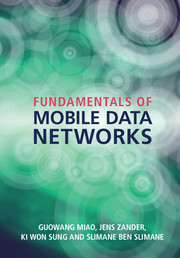Book contents
- Frontmatter
- Contents
- Preface
- Acronyms
- Notations
- 1 Introduction
- 2 Wireless network models
- 3 Medium access control
- 4 Scheduling
- 5 Principles of cellular systems
- 6 Transmitter power control
- 7 Interference management
- 8 Association and handover
- 9 Energy-efficient design
- 10 Long term evolution
- 11 Wireless infrastructure economics
- About the authors
- Index
- References
3 - Medium access control
Published online by Cambridge University Press: 05 March 2016
- Frontmatter
- Contents
- Preface
- Acronyms
- Notations
- 1 Introduction
- 2 Wireless network models
- 3 Medium access control
- 4 Scheduling
- 5 Principles of cellular systems
- 6 Transmitter power control
- 7 Interference management
- 8 Association and handover
- 9 Energy-efficient design
- 10 Long term evolution
- 11 Wireless infrastructure economics
- About the authors
- Index
- References
Summary
Overview
In wireless networks, multiple terminals need to communicate at the same time and a medium access control (MAC) protocol allows several terminals to transmit over the wireless channel and to share its capacity.MAC protocols multiplex several data streams of different terminals to share the same channel and deal with issues such as addressing, how a terminal obtains a channel when it needs one, and so forth.
The design of MAC protocols closely relates to the condition of the physical channels. Initially MAC protocols were designed for wired communications where multiple computers need to transmit data packets at the same time in a local area network (LAN). With wired networks, the physical medium can be copper or fiber optics, which are in general very reliable with abundant bandwidth. Packet loss in wired networks is mainly due to collisions and the MAC designs are relatively simple.
The MAC design in wireless networks is much more challenging. The difficulties lie in the following aspects. With wireless communications, a radio signal may experience reflection, diffraction or scattering before reaching its receiver. Any of them will deteriorate the signal and incur variation of signal quality in time, frequency and space. Another main issue is the broadcast nature of wireless channels. For reliable transmission against fading, strong radio transmission power needs to be used by the transmitter. This incurs strong interference with other terminals in the vicinity. The stronger the transmission power or the closer the neighboring terminals, the stronger the interference will be. Because of fading and interference, wireless networks are more vulnerable compared to wired ones. Usually the bit error rate of wired networks is better than 10−6 and that of wireless ones is worse than 10−3. The difficulty also lies in the fact that wireless terminals usually have to operate in half-duplex mode. This is because transmission power is in general much stronger than reception power, and with full-duplex operation the leakage of transmission power to the receiver component will incur very strong self-interference and therefore the terminal will not be able to receive packets or detect a collision when it is sending.
MAC schemes can be divided into two categories, contention-free and contention-based protocols. A contention-free MAC protocol requires a central controller to coordinate the resource allocation and the central controller can be a base station in a cellular network or an access point in a wireless local area network.
Information
- Type
- Chapter
- Information
- Fundamentals of Mobile Data Networks , pp. 27 - 64Publisher: Cambridge University PressPrint publication year: 2016
